What types of radiators are better: a comparative review of all types of heating batteries
The duration of the heating season in our latitudes is close to 2/3 of the year. The indicator depends on the region, but on average it is about 250 days.For us, all issues related to the efficiency of the heating system are extremely important, which largely depends on the correct choice of its devices.
Let's look at which heating radiators are better and what the different types are. The article presented for consideration describes in detail the criteria for selecting heating devices. For independent home DIYers, we have provided tips from experienced plumbers.
The content of the article:
Main characteristics of a typical radiator
Regardless of the complexity of the heating system, the main task is to maintain the set temperature in the house or apartment. The heating radiator plays a key role in this, carrying out heat exchange between the air in the room and the coolant.
Uniform heating, efficient heat transfer, microclimate maintenance, stable operation - these are the main requirements for a heating battery.
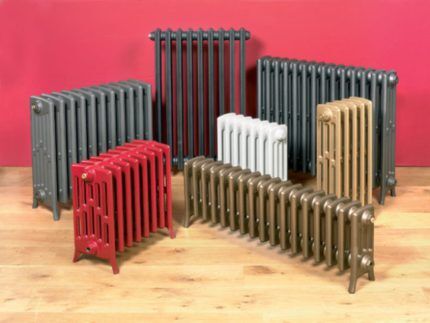
The main parameters influencing the choice of a specific model:
- System operating pressure. Depends on whether the device is connected to an autonomous or centralized network. It is arranged on a gravity or forced principle. On average it varies from 3 to 10 bar or in a similar atmosphere range.
- Thermal power. A characteristic required to calculate the thermal power required to heat a room. It is also needed for selecting individual components of sectional batteries. Approximately 1 kW is required to process 10 m².
- Modularity. The quality inherent in prefabricated radiators, which makes it possible to assemble and disassemble the device to suit individual requirements.
- Speed of reaction to tº. More precisely, the ability to respond to changes in coolant temperature. period of time for cooling and warming up.
- Possibility of equipping with automation. Devices that monitor weather conditions and independently eliminate air jams.
The devices now available for sale ensure free circulation coolant liquid according to the system. They are characterized by corrosion resistance and attractive appearance.
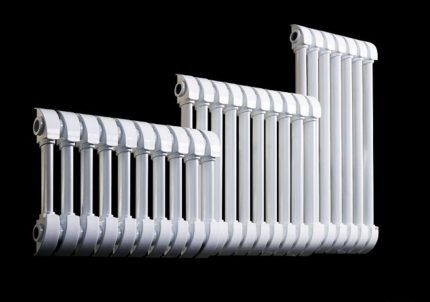
The thermal efficiency of a radiator depends on the energy dissipation surface area. A flat metal convector has a much smaller area compared to a sectional aluminum convector of the same geometric size. Because the latter radiates heat over the entire area of the fins.
Types of modern heating radiators
During Soviet times, the question of which heating battery is better to choose was never asked for a simple reason. The industry produced only two types of them - steel and cast iron. We live in a fortunate time of diversity, technological and environmental excellence.
The global and domestic industry offers a fairly wide range to choose from. There are several signs according to which it is advisable to separate heating radiators.
Radiators can be divided according to materials of manufacture:
- steel panel convectors;
- cast iron batteries;
- aluminum radiators;
- bimetallic radiators.
By design features:
- sectional;
- panel.
Each of these types is best suited for its operating conditions, and therefore has its own nuances. A separate type of heating radiators is highly specialized. These are devices designed to solve one task, often to the detriment of overall functionality.
Specialized types include floor convectors, have recently become increasingly popular. Mounted on the floor, used for large glass areas.
Their disadvantages of floor convectors are their limited efficiency, which is justified by their small height, and therefore, their small heat transfer area. However, they allow not only to heat the room, but also to form a thermal curtain against drafts, and also prevent windows from fogging up.
Eat baseboard convectors, which are mounted in long metal boxes installed instead of baseboards.All connections and adjustments are also covered with a plinth. They are convenient because they do not interfere with the overall design of the room.
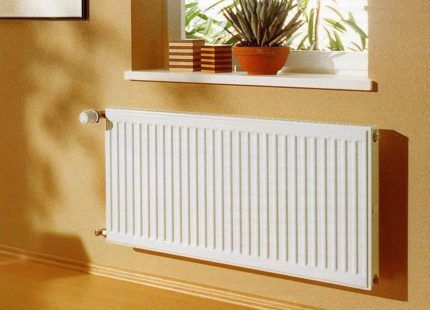
Designer radiators come in all sizes and configurations. Made from various materials: cast iron, steel, aluminum. The main disadvantage is the high price.
For baths and showers, special radiators are used - heated towel rails. They are distinguished by simplicity of design and protection from high humidity. Made of stainless steel or steel with chrome plated.

Let's talk in more detail about classic radiators and analyze the advantages and disadvantages of each material separately.
Type #1 - steel panel convectors
The steel radiator has a strong monolithic design. Heat exchange plates are placed in a casing.

The design of a steel convector consists of steel tubes and plates. To give an aesthetic appearance, everything is placed in a steel casing. Thanks to the flat and smooth surface of the casing, less dust accumulates on it, and the device is easier to care for.
Steel convectors are popular due to their low price. They are lightweight and do not require reinforced brackets for installation. Design features ensure active circulation of air masses. The outer casing does not get very hot, it is difficult to get burned.
They come from the manufacturer in finished form and do not require modifications.Due to the non-separable design, no leaks are guaranteed. They have average inertia. Steel heating appliances Suitable for all types of circuits.
Among the disadvantages of steel batteries:
- Low corrosion resistance. Corrosion-sensitive material is used in production.
- Fast cooling. In the event of an emergency shutdown of the system, the device will almost instantly lose operating temperature.
- Low heat transfer. Due to the small total radiation area.
- Limited service life, especially with low-quality coolant.
Water hammer is also possible - it occurs when two flows meet: liquid and air that has not been removed from the system. The liquid is incompressible, excess pressure at the meeting point of the flows is transferred to the pipe walls. Particularly dangerous for multi-storey buildings.
Type #2 - classic cast iron batteries
Traditional cast iron radiators have a bulky and simple appearance.The modern design of cast iron batteries can easily compete with advanced models. They delight you with a simple and smooth surface that is easy to clean.
Structurally, they are made of individual ribs, which can be assembled individually, directly on site. A separate section has high power. Due to thick cast iron, they have great weight and high inertia.
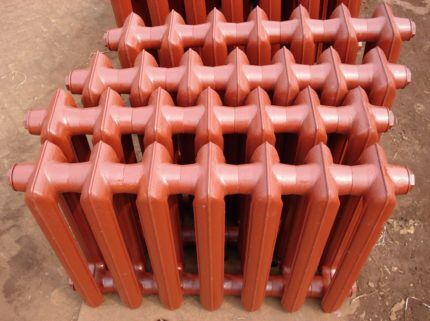
Cast iron radiators take a long time to heat up and take a long time to cool down. Massive devices have the longest service life and are attractive at an affordable price. Almost insensitive to the quality of the coolant.
Cast iron batteries are used mainly in facilities with centralized heating. They are suitable for autonomous systems with natural coolant circulation. In other individual heating schemes they are not recommended.
It's all about the inertia of cast iron appliances, which slowly respond to changes in background temperature. In houses with climate control they are not compatible: because... both will function at odds. In addition, most models cannot be equipped with automation.
Disadvantages include:
- Impressive mass. Installation requires the use of reinforced brackets.
- Restrictions on use. Installation in most stand-alone systems is impractical.
- Slow heating. It takes considerable time to heat the device and the medium being processed - the inertia of such radiators is very high.
- Sensitivity to water hammer. Before purchasing, you should definitely look at what pressure a device made of brittle cast iron can withstand, and take into account the likelihood of water hammer in the system.
- Small heat transfer area. The simple design of the fins cannot provide good air convection.
The capacity of cast iron sections is from 2.5 to 3 liters. They work quietly under a pressure of 6 bar. There are cast iron models designed for installation in systems with a pressure of 9 bar, which can briefly withstand an increase to 16 bar.
Inertia is the rate of heat transfer from the radiator to the surrounding air. The greater the inertia, the longer the radiator takes to heat up and cool down. For example, imagine a brick oven. Remains hot even after the fire has gone out, but takes a long time to heat up.
Type #3 - aluminum radiators
Aluminum radiators attract with an interesting design. The complex panel profile ensures high heat dissipation efficiency, which means high performance in a small footprint. True, it is difficult to clean such radiators due to the developed and ornate surface of the sections.
Aluminum batteries are divided into sectional, collapsible and solid. Designed for average coolant pressure. The power of an individual rib is less than that of cast iron.
They have low inertial properties: they heat up and cool down fairly quickly. Aluminum radiators Excellent for individual autonomous heating.

The scope of application of such radiators is limited due to the inherent disadvantages of aluminum:
- Sensitive to the quality of the coolant. The low weight and dimensions of the devices make it possible to reduce the diameter of pipelines. Narrow pipes can quickly become clogged with scale and sand.
- Relatively high price. The cost of aluminum appliances makes us wish for more humanity on the part of manufacturers.
- Weak resistance to water hammer. Aluminum is essentially a ductile material that cannot resist high mechanical and hydraulic pressure.
The best representatives of “aluminium” are products made from AI-Si, capable of operating in systems with a pressure of 6 bar. section volume 0.5 l. Strongly recommended for installation in private homes, especially with climate control systems.
Aluminum is a chemically active element. Easily reacts with alkaline additives, often used in coolant, for central heating. Does not allow the use of copper fittings.
Type #4 - bimetallic radiators
Bimetallic radiators are a variant of modernized aluminum counterparts, reinforced with steel elements to increase pressure resistance. IN bimetallic models Only the channels connecting the radiator collectors or the entire internal component can be made of steel - i.e. both channels and collectors.
In the latter option, contact of aluminum with the coolant is completely eliminated. This extends the service life and reduces the frequency of system maintenance. The union of two metals has good convection and is suitable for installation in private and individual homes.
The list of shortcomings includes:
- High price. The devices are not very attractive due to their affordable price.
- Complex composite surface. They are not easy to clean and you need to constantly ensure that dust deposits do not accumulate on the surface.
The volume of the sections depends on the manufacturer and ranges from approximately 0.17 to 0.3 liters. Withstand pressure 16 - 40 bar. Depending on the model, they can briefly resist pressure of 24 - 60 bar.
*Bimetallic is not an alloy, but rather a combination of two metals. Therefore, the coolant energy is transferred, first to the steel pipe, then to an aluminum or copper heat exchanger.
Selecting a radiator for your heating system
The heating scheme largely determines which radiators are best suited in each specific case. A single-pipe heating scheme involves the supply and removal of coolant to the radiator through one pipe. With such a system, each battery is connected in series, in a chain, to a common riser.
It is used less and less, as it has a number of disadvantages: the complexity of setting up the system, since changes in one radiator affect all the others, the presence of a common riser of a large diameter.
With a two-pipe heating scheme, the radiators are connected in parallel: one pipe supplies the coolant, the second drains it. This system requires much more piping but does not have the disadvantages of a single pipe system. Adjusting one radiator has virtually no effect on the others.
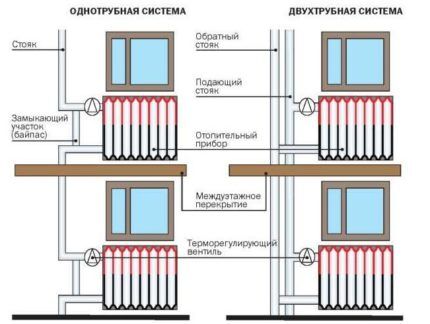
Based on the characteristics of communication between the coolant and the atmosphere, heating circuits are divided into open and closed. At open system, at the highest point there is an expansion tank that communicates directly with atmospheric air. Circulation in such a system is carried out naturally, due to the slope of the pipelines and the difference in pressure of the hot and cold coolant.
The closed system has a special expansion tank with a diaphragm. The coolant does not come into contact with atmospheric air. In such a system there is forced circulation, which is much more reliable and does not require slopes. Most modern systems are closed.

With an open heating system, excess pressure pushes the coolant into the expansion tank, which is directly connected to the atmosphere. This coolant contains a high percentage of oxygen, which causes corrosion.
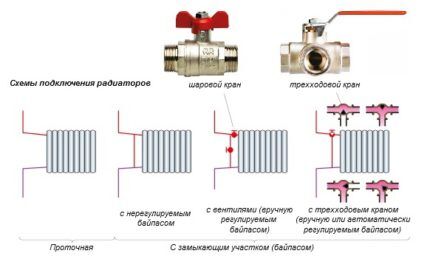
With a two-pipe system, radiators are connected in parallel, and the coolant has no contact with atmospheric air.
Specifics of central heating
With central heating, the coolant is under high pressure. Circulation may not occur continuously. Therefore, it is advisable to use radiators with high inertial properties.
Capable of storing heat during intensive circulation, preventing the room from overheating. And vice versa, do not cool down so quickly when circulation stops.
The higher the inertia of the radiator, the more even the temperature will be maintained in the room. With central heating, ordinary process water acts as a coolant.
However, due to the extended and complex system, it is sometimes highly polluted and gassed. As a result, the coolant causes increased corrosion.The accompanying sediment will clog the narrow channels of the radiators, significantly reducing the effective heat transfer.
Features of autonomous heating
The basis of an individual heating system is most often gas boilers or similar equipment running on liquid fuel or pellets. Particularly effective with a two-pipe system.
Such a system is closed, the coolant circulation is constant and is carried out using circulation pump. Boiler equipment turns on automatically, depending on the temperature of the coolant.
When configured correctly, it allows you to achieve very efficient operation. Using low-inertia radiators and a comb system, it actually supplies coolant only to the required heating radiator. This happens due to constant circulation.
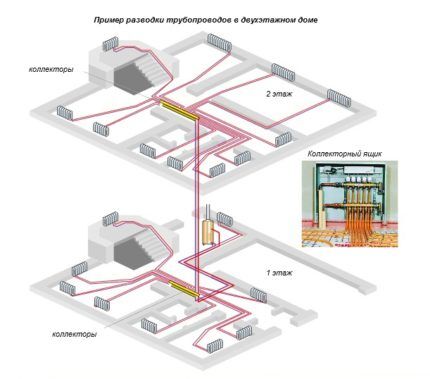
In such a radiator, the flow occurs faster, the lower the coolant temperature. The hot coolant will flow directly into the coldest radiator, due to the greatest pressure difference.
Since the automation of heating equipment constantly maintains the set temperature of the coolant: the lower the inertia of the radiator, the more accurately the temperature in the room will be maintained. Characterized by high quality coolant and lack of gas contamination, low pressure.
Individual heating using solid fuel is based on manually loaded boilers. In particular, this leads to significant changes in coolant temperature during the day.To reduce the cost of the entire system, very often, an open-type single-pipe system is used (communicated with atmospheric air).
With a single-pipe gravity flow design, the pressure in the system is minimal, the coolant is contaminated with corrosion products and gassed. It is desirable to use radiators with high inertia and corrosion resistance.
About the principles of the two-pipe system and options connecting radiators You can read about it in the article we recommend for you to read.
Individual heating of a summer house or hunting lodge is distinguished by the ability to reduce the temperature of the coolant to negative temperatures. Special antifreezes are used as a coolant; among other advantages, they have anti-corrosion properties.
The system is characterized by low pressure. To quickly warm up all rooms, a reasonable choice would be to use radiators with minimal inertia.
Additional installation tips
The efficient, reliable operation of the heating system is influenced not only by the correct choice of the type of heating radiator.
There are a few simple installation rules:
- The distance to the wall is at least 4 cm.
- The distance to the floor and window sill is at least 10 cm.
- The size is no more than 75% of the width of the opening being constructed.
Distances affect the correct distribution of air flows, ensuring uniform and rapid heating of the room. In addition, distances are important for fire safety if the floor consists of flammable materials (parquet, boards, linoleum).
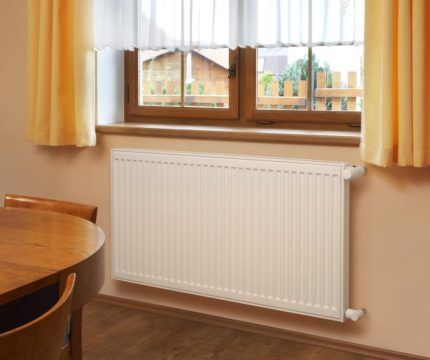
The use of a decorative screen will reduce the efficiency to 15-20%.Incorrect connections to the supply and return pipes will reduce productivity by up to 20%. The most effective solution is to connect the supply pipe to the top of the radiator, and the outlet to the bottom of the radiator.
Information on methods of connecting heating devices, taking into account the requirements of building regulations, is given here.
Conclusions and useful video on the topic
Useful tips from experts will help you understand the choice of heating device:
The best choice of heating radiator can be considered the one that achieves the greatest comfort and coziness. The radiator can be invisible or, on the contrary, be part of the overall design. But the most important thing is reliability and no hassle.
You can tell us about how you chose a radiator to replace old batteries in an apartment or to furnish a new home in the block below. Please write comments, ask questions, share useful tips and photos on the topic of the article. We are interested in your opinion.




It is clear that the choice is now very wide. However, as before, I prefer exclusively cast iron radiators precisely because of their durability and ability to retain heat longer. In principle, they provide more uniform and smooth heating of the room. If you buy something from modern samples, then it is better not to skimp and take bimetallic radiators.
We have aluminum batteries in our apartment building; it’s cheaper for the developer. It’s not cold in winter, and in a room with heated floors we don’t turn on the radiators at all. The temperature on the boiler is a maximum of 45 degrees at -25.And in old houses with central heating, cast iron radiators are covered with a blanket, because the house is very hot and the air is dry. The only difference is that cast iron gives off heat longer and does not cool down so quickly. I wonder how profitable it is to install floor convectors in a private house?
It is good to install a floor convector when you have a window covering the entire wall. If this is so, then it will do a good job of eliminating drafts and generally heating the room.
In other cases, I don’t see the need for it. A better combination of conventional bimetallic radiators and heated floors has not yet been invented. Well, insulate the house well so that the heat does not escape.
Most likely we are talking about an in-floor convector.
A pressing question for me. Last year I replaced old Soviet radiators with modern ones. Then I didn’t think twice and bought aluminum ones, guided only by the price. They don't heat well, air accumulates all the time, one even started leaking and had to be repaired. I'm going to buy new ones in the spring, I want to approach the issue wisely in order to choose the most suitable option.
Hydrogen regularly accumulates in aluminum heating devices as a result of a chemical reaction between aluminum and the coolant.
Please tell me, are bimetallic batteries suitable for a gravity heating system?
Hello. Yes, sure.
Hello! Help with the choice of radiators and pipe diameters for installing an autonomous heating system, provided the house is 80 sq. m. m., 8 radiators, closed type system “Leningradka” Supply, return bottom, bottom.